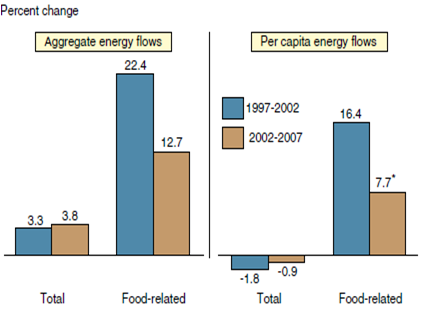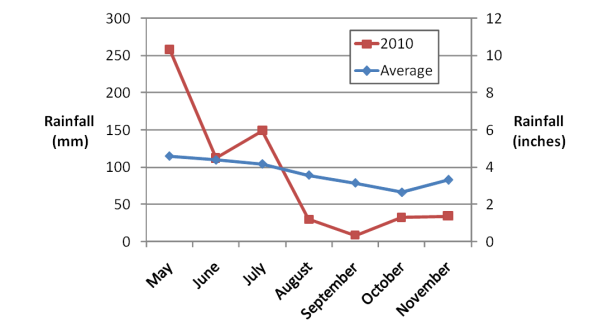Can't find what you're looking for?
The Energy Farms network blog recently moved to a new WordPress server. Only the most recent posts were transferred. Older posts are archived here.
Farm Scale Study: Summary of 2010 Results
Last year was a bad year for our Energy Farm yields. The summer began with flooding and ended with drought.
BioChar Stove How To: Become a Pyroneer
This is a cross post from my Personal Blog where I detail my work in South Central Wisconsin and its focus on sustainability, appropriate technology and small scale agriculture as we seek to reskill and transition to a less energy dependent future.

Rob's Quick & Dirty TLUD Stove. $50 and one hour of fab time. About 20-30# of char per firing, 2-3 hour burn time.
I garden for many reasons, but mostly to Be the Change I wish to see in the world. And the more I read about our need to relocalize, the more I hear about how screwed up our climate is getting, the more I read about how very real the pressures of Peak Energy are going to be, the more convinced I am that Bio-Char is an absolutely critical component in any transitional farming system. The hard truths of our age are that we have far too many mouths to feed, we have far too much carbon in the air, our soils are denuded to all hell, and we will need local means to produce energy cause the cheap, easy stuff is gone. Guess what – biochar can help ALL of these. By growing coppice biomass plantations as windbreaks around CSA farm plots or in unused/unusable portions of our farms we can tap into fast growing plant’s abilities to pull carbon from the air and “fix” it into biomass. This biomass can then be turned into biochar, which reduces syck amounts of heat that can be captured for use in myriad ways from making maple syrup and canning tomatoes, to methane and ethanol. Best of all, the resulting char can be run through a composting regime, charged with nutrients and micro-organisms, and added to the soil for simply incredible results that increase fertility over millenia – your yeilds go up and and your farming goes regernerative as you sequester the airborne C02 in the soil. Congrats – your farm is now Carbon NEGATIVE.
The One Straw Energy Farm: Virtual Tour
Rob Frost maintains the One Straw blog, where he reports on practical efforts to find “personal solutions to the Big Problems of today.” He is establishing an Energy Farm on 20 acres in South Central Wisconsin. Rob laid out his vision for the farm in his Making an Energy Farm post in April. Last week he offered a virtual farm tour, cross-posted here with permission.

Would like to spend some time fleshing out some more of my thoughts on my Energy Farm project. First off, thanks to a great shot that the owners, Mike and Ellen, where able to take from a small plane (the farm is next to our community airport and they had an open house with plane rides for $25) I can better show the current State of Affairs. The farm is located within the city limits (though only just) of a town of about 20,000 people and is located on the edge of an industrial area – indeed it is currently zoned industrial and would have potentially become a factory had the owners not saved it from sprawl. The home has not been lived in by humans for over 15 years – though several generations of racoons have been raised there apparently… The barn is in fairly good shape, though the roof and foundation need some TLC which is being applied in spades by Mike.
A description of our farm
Chris Saenz maintains the Woodgas Wiki and experiments with energy-efficient technology and small scale renewable energy production on his family’s land in the Kentucky hills. Here, he introduces himself and the land [ed].
This started out as an email to a friend. I thought with some work it could be blog-worthy.
We own about 30 acres in the hills of Kentucky. The land is not gently rolling hills, like most of the state. We have Appalachian style hollows and high ridges. Our own hollow has about 10 houses. Only a few locals are left, the rest have moved in from the “outside”; mostly folks from California and Florida who cashed in.To get to our house, you follow a narrow paved road up the creek, which gets narrower and less paved as you go. We are at the head of the valley, where it meets another hollow coming in from the east, in a sort of L shape. And so the road takes a right turn by our house, and goes on up the other hollow. The house is set up on a hill. It is a large white Amish built house, with two floors above a walkout basement, and a deep porch in the front.
Beyond Food Miles
Article released today
by the Post Carbon Institute
“There is nothing as deceptive as an obvious fact”
-Sherlock Holmes
 A locavore is “a person who endeavors to eat only locally produced food” [1]. What better diet could there be for an energy constrained world? After all, feeding Americans accounts for about 15% of US energy use [2], and the average food item travels more than 5,000 miles from farm to fork [3]. It seems obvious that eating locally will go a long way to reducing food system energy use.
A locavore is “a person who endeavors to eat only locally produced food” [1]. What better diet could there be for an energy constrained world? After all, feeding Americans accounts for about 15% of US energy use [2], and the average food item travels more than 5,000 miles from farm to fork [3]. It seems obvious that eating locally will go a long way to reducing food system energy use.
Yet cracking the case of America’s energy-intensive food system demands that we look beyond the obvious. A local diet can reduce energy use somewhat, but there are even more effective ways to tackle the problem. Single-minded pursuit of local food, without consideration of the bigger picture, can actually make things worse from an energy perspective [4].
Read more…
Energy and Vertical Farms
Vertical farming is hot.
The idea that we should grow food under highly-controlled conditions in urban high-rises is getting plenty of media attention, along with pleas for public and private investment. A new vertical farming book by retired Columbia professor Dickson Despommier came out in October, and Sting bought the movie rights.
Vertical farm promoters claim these buildings will solve every problem from farmland shortages to population growth. They seem particularly fond of futuristic renderings of glassy skyscrapers alive with plants bathed in electric light. The grow lights are necessary because most crops would fail under the meager ration of sunlight that could filter into the depths of a skyscraper.
Proponents of vertical farming commonly say it will save energy by eliminating the need for tractors, plows, and shipping. Some even think that vertical farms can incorporate enough solar panels, wind turbines, and methane generators to be net energy producers. For the most part, vertical farms are more vision than reality, but a few real-life examples are appearing, offering opportunities for critical evaluation of proponents’ claims. In this post I examine one such example from a farm energy perspective.
 In a previous post I contrasted Kentucky’s energy plan with Ireland’s. Both plan to grow biomass to offset some of their fossil fuel use, but Ireland consumes far less fossil fuel than Kentucky, so can offset a much larger proportion of its energy use with each bale of switchgrass. Ireland is planning to further reduce its energy use, while Kentucky is planning for growth. My analysis of traffic volume trends leads me to believe that Kentucky’s transportation growth forecasts will not materialize.
In a previous post I contrasted Kentucky’s energy plan with Ireland’s. Both plan to grow biomass to offset some of their fossil fuel use, but Ireland consumes far less fossil fuel than Kentucky, so can offset a much larger proportion of its energy use with each bale of switchgrass. Ireland is planning to further reduce its energy use, while Kentucky is planning for growth. My analysis of traffic volume trends leads me to believe that Kentucky’s transportation growth forecasts will not materialize.

Change in U.S. total and food system energy consumption over two five-year periods (1997-2002 and 2002-2007). Figure from Canning et al., 2010. Click image for report.
Energy used by the US food system accounted for 80% of the increase in American energy use between 1997 and 2002, according to a recent report from the USDA’s Economic Research Service. Other remarkable conclusions of the analysis include:
- Food system energy use increased by 22.4% while total energy use rose by just 3.3%.
- On a per capita basis, total energy use actually fell by 1.8%, but food system energy use was still up by 16.4%.
- Putting food on the plate of the average American required 2.4 million BTU more in 2002 than in 1997. (To put this in context, total per capita energy consumption of 20 nations was less than 2.4 million BTU in 2002.)
- The period between 2002 to 2007 likely saw another jump in food system energy use that far exceeded the increase observed in the rest of the US economy.
Help Wanted… Organic Energy Farm Research
 The Land Grant Program at Kentucky State University seeks a full-time research assistant for work related to energy conservation and renewable energy production on organic farms. The research assistant will work closely with students involved with the project and with small farmers interested in the potential to apply our findings on their own farms. The work is part of a larger effort to assess the potential of Kentucky’s small farms to meet their own fuel needs sustainably. Read more…
The Land Grant Program at Kentucky State University seeks a full-time research assistant for work related to energy conservation and renewable energy production on organic farms. The research assistant will work closely with students involved with the project and with small farmers interested in the potential to apply our findings on their own farms. The work is part of a larger effort to assess the potential of Kentucky’s small farms to meet their own fuel needs sustainably. Read more…
Google Invests In Wind Power Technology
 Last Friday, Google made a sizable investment of $38 million to North Dakota based wind farms. These wind farms harness the wind energy of the North Dakota plains to create electricity that can power more than 55,000 homes and does so in a clean and safe manner. Google understands that an investment of this size, in a technology as beneficial as wind energy, can help create more wind farms around the country, create more jobs within this clean energy, and help stimulate the economy. For Google, it’s as much about helping the environment, as it’s about making smart business decisions about the future of this planet. Other corporations like Globetrotters Corporation (a Chicago based engineering corporation founded by C.E.O. Niranjan Shah) and Hewlett-Packard are following in the same footsteps as Google. These companies are coming to the conclusion that investing in green technology and green energy is really an investment in the future of the technology, the planet, and even their own businesses.
Last Friday, Google made a sizable investment of $38 million to North Dakota based wind farms. These wind farms harness the wind energy of the North Dakota plains to create electricity that can power more than 55,000 homes and does so in a clean and safe manner. Google understands that an investment of this size, in a technology as beneficial as wind energy, can help create more wind farms around the country, create more jobs within this clean energy, and help stimulate the economy. For Google, it’s as much about helping the environment, as it’s about making smart business decisions about the future of this planet. Other corporations like Globetrotters Corporation (a Chicago based engineering corporation founded by C.E.O. Niranjan Shah) and Hewlett-Packard are following in the same footsteps as Google. These companies are coming to the conclusion that investing in green technology and green energy is really an investment in the future of the technology, the planet, and even their own businesses.





